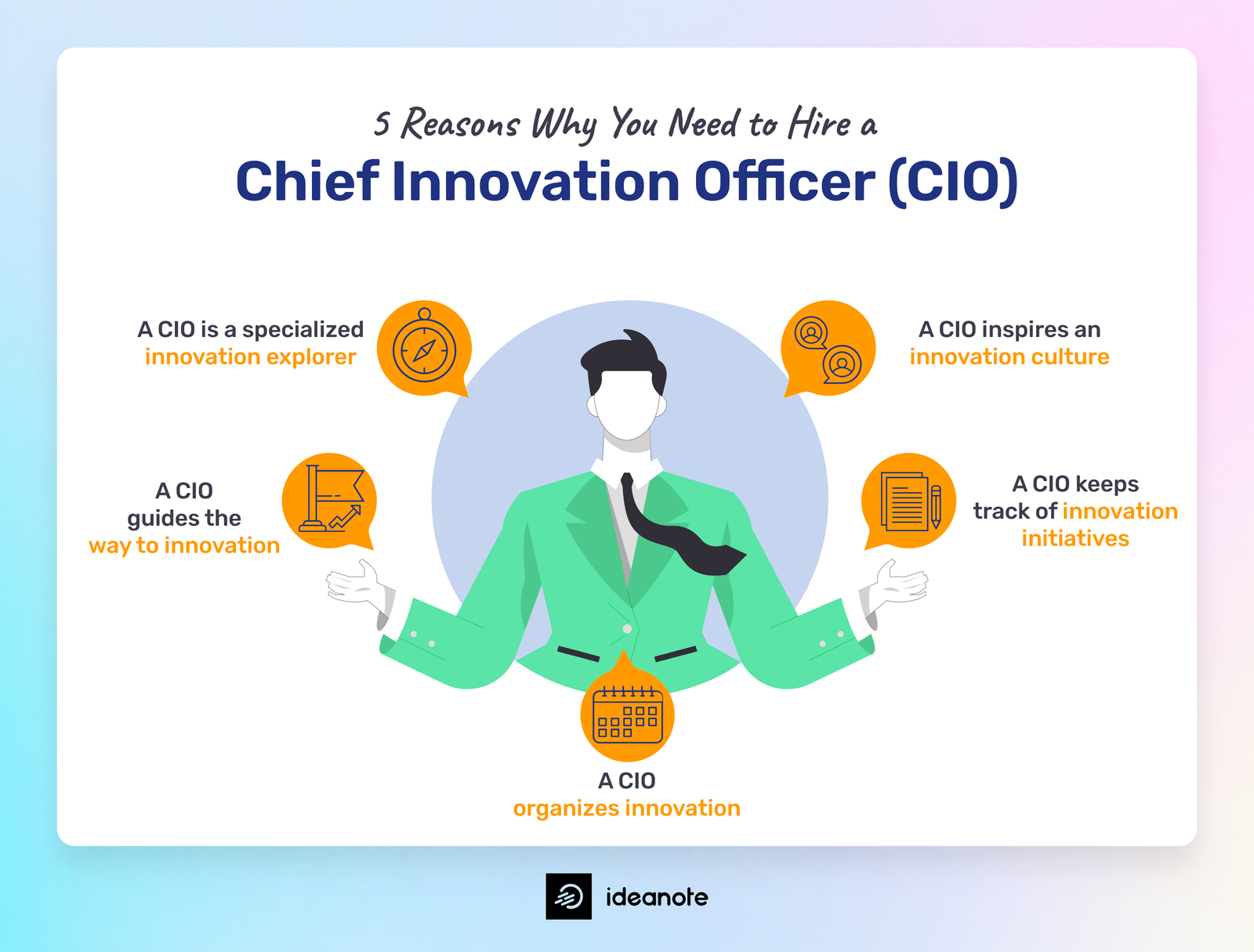
Chief Innovation Officer: What to Expect : The Future of Innovation in 2024
Defining the Chief Innovation Officer
The Chief Innovation Officer, often referred to as the CIO, is a C-suite executive responsible for leading innovation efforts across an organization. Unlike the Chief Technology Officer (CTO) who focuses primarily on technology infrastructure, the CIO’s role is broader and more strategic, encompassing innovation in products, services, processes, and business models.
Responsibilities of a Chief Innovation Officer
Driving Innovation Strategy
One of the primary responsibilities of a CIO is to develop and execute a comprehensive innovation strategy aligned with the company’s overall objectives. This involves identifying emerging trends, market opportunities, and disruptive technologies that can drive growth and create competitive advantage.
Leading Cross-functional Teams
Effective innovation requires collaboration across departments and disciplines. As such, CIOs often work closely with R&D teams, marketing, sales, and other functional areas to foster creativity, break down silos, and ensure alignment towards common goals.
Cultivating a Culture of Innovation
A key role of the CIO is to nurture an environment where innovation thrives. This includes fostering a culture of experimentation, risk-taking, and continuous learning, where employees feel empowered to contribute ideas and challenge the status quo.
Fostering Partnerships and Collaborations
Innovation often happens through partnerships and collaborations with external stakeholders such as startups, universities, and research institutions. CIOs play a crucial role in identifying and nurturing these relationships to access new technologies, talent, and market opportunities.
Qualities of a Successful Chief Innovation Officer
Visionary Leadership
Successful CIOs possess a clear vision for the future and the ability to inspire others to share in that vision. They are adept at articulating a compelling narrative that motivates employees and stakeholders to embrace change and pursue ambitious goals.
Strategic Thinking
Innovation requires a strategic approach that balances short-term objectives with long-term vision. CIOs must have the foresight to anticipate market trends, identify growth opportunities, and allocate resources effectively to drive sustainable innovation.
Risk-taking and Adaptability
Innovation inherently involves risk, and CIOs must be comfortable taking calculated risks and navigating uncertainty. They must also be adaptable and agile, capable of quickly adjusting course in response to changing market conditions or unforeseen challenges.
Communication and Collaboration Skills In Chief Innovation Officer
Effective communication is essential for rallying support, building consensus, and aligning stakeholders around shared objectives. CIOs must excel at communicating complex ideas in simple terms and fostering collaboration across diverse teams and geographies.

Challenges Faced by Chief Innovation Officer
Overcoming Resistance to Change
One of the biggest challenges for CIOs is overcoming resistance to change within the organization. Innovation often disrupts existing processes and workflows, leading to resistance from employees who are comfortable with the status quo. CIOs must be adept at managing change, addressing concerns, and gaining buy-in from stakeholders at all levels.
Balancing Short-term Goals with Long-term Innovation
In the fast-paced world of business, there is often pressure to deliver immediate results and meet short-term targets. However, sustainable innovation requires a long-term perspective and investment in research, experimentation, and development. CIOs must strike a balance between meeting short-term objectives and investing in the future.
Managing Resource Constraints
Innovation initiatives require resources, including funding, talent, and time. However, CIOs often face constraints in terms of budgetary limitations, talent shortages, and competing priorities. Managing these resource constraints effectively is essential for driving innovation within the organization.
Strategies for Effective Innovation Leadership
Establishing Clear Goals and Metrics
To drive successful innovation, CIOs must establish clear goals and metrics to measure progress and evaluate the impact of innovation initiatives. This involves defining key performance indicators (KPIs), setting targets, and regularly tracking and reporting on results.
Encouraging Experimentation and Learning from Failure
Innovation inherently involves experimentation, and not all experiments will succeed. CIOs must create a culture where failure is seen as a learning opportunity rather than a setback. Encouraging experimentation, celebrating successes, and learning from failures are essential for fostering a culture of innovation.
Building a Diverse and Inclusive Team
Diversity of thought and perspective is critical for driving innovation. CIOs must actively promote diversity and inclusion within their teams, ensuring that a wide range of voices and experiences are represented. This diversity fosters creativity, sparks new ideas, and enables more robust problem-solving.
Leveraging Technology and Data
Technology is a powerful enabler of innovation, providing new tools and platforms to drive growth and efficiency. CIOs must stay abreast of emerging technologies and trends, and leverage data and analytics to inform decision-making and identify opportunities for innovation.
The Future of the Chief Innovation Officer Role
Embracing Disruptive Technologies
The pace of technological change continues to accelerate, with disruptive technologies such as artificial intelligence, blockchain, and IoT reshaping industries and business models. CIOs must embrace these technologies and explore how they can be leveraged to drive innovation and create value for the organization.
Driving Sustainability and Social Impact
In addition to driving financial performance, CIOs are increasingly tasked with driving sustainability and social impact initiatives. This includes reducing environmental footprint, promoting diversity and inclusion, and addressing social challenges such as poverty and inequality. CIOs play a critical role in driving these initiatives and embedding them into the organization’s culture and strategy.
Evolving Role in the Digital Age
As businesses become increasingly digital and interconnected, the role of the CIO is evolving. CIOs are no longer just responsible for IT infrastructure but are strategic partners driving digital transformation and innovation across the entire organization. This requires a broader skill set and a deeper understanding of business strategy, customer experience, and emerging technologies.
Collaborating with Startups and External Partners
Innovation ecosystems are increasingly global and interconnected, with startups, accelerators, and incubators playing a key role in driving innovation. CIOs must actively engage with these external partners, seeking out opportunities for collaboration, investment, and co-innovation to stay ahead of the curve and drive sustainable growth.
Conclusion about Chief Innovation Officer :
Innovation is the lifeblood of organizations in today’s fast-paced and competitive business environment. Chief Innovation Officers play a pivotal role in driving innovation strategy, fostering a culture of creativity and experimentation, and positioning their organizations for long-term success. By embracing the challenges and opportunities of the digital age, CIOs can lead their organizations to new heights of innovation and competitiveness.
FAQs
1. What qualifications does a Chief Innovation Officer typically possess?
Chief Innovation Officers typically have a strong background in business strategy, innovation management, and leadership. They often hold advanced degrees such as MBAs or PhDs and have extensive experience in roles involving innovation, strategy, and technology.
2. How can organizations measure the success of their innovation initiatives?
Organizations can measure the success of their innovation initiatives using a variety of metrics, including revenue growth, market share gains, customer satisfaction scores, and the number of new products or patents generated. Qualitative measures such as employee engagement, collaboration, and culture of innovation are also important indicators of success.
3. What industries are Chief Innovation Officers most commonly found in?
Chief Innovation Officers can be found in a wide range of industries, including technology, healthcare, finance, manufacturing, and consumer goods. Any industry that values innovation and seeks to stay ahead of the competition is likely to have a CIO or equivalent role.
4. How can companies foster a culture of innovation?
Fostering a culture of innovation requires leadership commitment, employee empowerment, and a supportive organizational environment. Companies can encourage innovation by providing resources and incentives for creativity, promoting diversity and inclusion, and celebrating risk-taking and experimentation.
5. What role does technology play in driving innovation?
Technology plays a critical role in driving innovation by providing new tools, platforms, and capabilities to solve complex problems, streamline processes, and create new products and services. Technologies such as artificial intelligence, machine learning, and big data analytics are particularly transformative and are driving innovation across industries.


